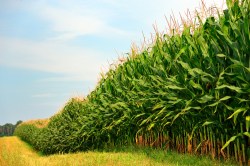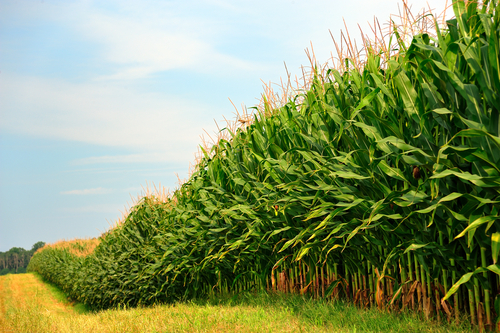
ShutterstockWe just can’t quit you, corn.
We at Grist go on and on about corn — how it’s far too dominant in the U.S. agricultural landscape, how it uses too much land, water, fertilizer, pesticides, and taxpayer dollars, and how it produces too little food. It’s a familiar refrain around here.
Last week, University of Minnesota agricultural scientist Jonathan Foley, author of peer-reviewed research into the global impacts of agriculture, took to the pages of Scientific American to declare that corn is far too dominant in the U.S. agricultural landscape, that it uses too much land, water, fertilizer, pesticides, and taxpayer dollars, and that it produces too little food. Foley goes so far as to use the language of the financial crisis to state plainly that:
The monolithic nature of corn production presents a systemic risk to America’s agriculture, with impacts ranging from food prices to feed prices and energy prices. It also presents a potential threat to our economy and to the taxpayers who end up footing the bill when things go sour. This isn’t rocket science: You wouldn’t invest in a mutual fund that was dominated by only one company, because it would be intolerably risky. But that’s what we’re doing with American agriculture. Simply put, too many of our agricultural eggs are in one basket. [emphasis added]
He sums up the argument against our over-reliance on corn elegantly.
Although U.S. corn is a highly productive crop, with typical yields between 140 and 160 bushels per acre, the resulting delivery of food by the corn system is far lower. Today’s corn crop is mainly used for biofuels (roughly 40 percent of U.S. corn is used for ethanol) and as animal feed (roughly 36 percent of U.S. corn, plus distillers grains left over from ethanol production, is fed to cattle, pigs and chickens). Much of the rest is exported. Only a tiny fraction of the national corn crop is directly used for food for Americans, much of that for high-fructose corn syrup.
When you calculate our corn production based on calories produced per acre — and account for the fact that a third of U.S. corn goes to livestock, which are actually not very efficient at converting it to meat — it turns out corn feeds a mere three people per acre. That, Foley points out, “is lower than the average delivery of food calories from farms in Bangladesh, Egypt and Vietnam.”
So much for real productivity. It reminds me of the common assumption that our healthcare system is the best in the world — except when it comes to actually keeping people healthy.
Why are farmers growing so much corn? It’s the economics, stupid. Foley reports that U.S. taxpayers spent $90 billion between 2005 and 2010 on corn-grower subsidies, and that’s without factoring in the additional financial boost from ethanol subsidies and mandates. Meanwhile, insurance payouts for last year’s drought may reach $20 billion, despite the fact that corn prices are very high — and total corn sales revenue broke records.
Record prices, sky-high federal subsidies, liberal land-use policies, and constant encouragement from federal agencies all drive farmers to plow under whatever else they might grow instead and replace it with corn. The last five years saw another 13 million acres of U.S. land converted to corn growing, at the expense of, reports Foley, “wheat (which lost 2.9 million acres), oats (1.7 million acres lost), sorghum (1 million acres lost), barley, alfalfa, sunflower and other crops.” Not to mention another 1.3 million acres of grassland over the same period.
So color me pleased when USDA Secretary Tom Vilsack announced at an agricultural conference that his agency was going to make a big push to increase crop diversity in order to make American agriculture more resilient in the face of a changing climate.
The term he threw around was “multi-cropping,” or growing a set of crops in sequence, rather than a single crop over and over (aka monocropping). Vilsack described some policies the USDA would need to adjust in order to, as he put it, “reduce the manmade barriers to multi-cropping.” He also held up as an example Ohio farmer David Brandt — a “mainstream” conventional farmer who has a national reputation in farm circles for his multi-cropping and soil-building techniques.
Of course, there’s one major human-made barrier to multi-cropping that may present the greatest challenge to Vilsack’s plan. And that’s $8-a-bushel corn. If you’re multi-cropping, you’re growing less corn — which means that while multi-cropping may be a more resilient system, given current federal subsidy, crop insurance, and market levels, it’s likely to be a less profitable one.
In true multi-cropping scenarios, farmers are also likely growing fewer biotech crops, since there aren’t a lot of GMO cover crops available (GMO alfalfa and canola being the notable exceptions). Brandt, for example, uses a mix of up to 10 different kinds of cover crops at once — no place for biotech there.
But reducing farmers’ reliance on biotech is not a point Vilsack is quite ready to make — in fact, in his speech, he went right from talking up cover crops, biodiversity, agro-forestry, and soil health to discussing the USDA’s attempts to address the issue of coexistence between biotech and conventional crops so that farmers have “an opportunity to choose the type of operation that’s best for their family and themselves.”
The last thing Vilsack wants farmers to think is that the USDA is suggesting they plant fewer GMOs. But putting real resources into multi-cropping, as he says the agency is planning to do, will accomplish just that.
If that’s how Vilsack slowly turns the USDA battleship away from biotech monocrops, so be it. And if highlighting the work of farmers who are more closely allied with the National Sustainable Agriculture Coalition (NASC) or the Rodale Institute — two ag organizations that have pioneered the use of cover cropping and crop rotations — isn’t politically viable (Brandt is a member of the Farm Bureau, the organization that best represents the interests of conventional commodity farmers), well, that’s okay, too.
When I asked Ferd Hoefner, policy director of the NASC, for his reaction to Vilsack’s new push for multi-cropping, he observed that it was a long time coming:
We have been working for 25 years to try to make farm programs and conservation programs work for diversified producers and work for resource-conserving crop rotations, cover crops, and rotational grazing options. It has been a lonely struggle … We have made very significant progress … but we have not really come close to transforming the system. We will be very supportive if the Secretary’s interest in multi-cropping helps move the needle and leads to better support for diversified farmers and for agricultural diversification in general.
Vilsack doesn’t yet have an answer for the question at the core of the problem: How do you convince farmers to do what is simply not in their economic interest? Our current system may a “house of cards,” as Foley calls it, where “a single disaster, disease, pest or economic downturn could cause a major disturbance in the corn system.” But it’s surrounded by a moat full of money.
Even so, it’s not a system that can continue on indefinitely. It sounds like Vilsack understands that better than most agriculture secretaries before him. But until the USDA (or, really, Congress) begins to dismantle the system of subsidies, policies, and mandates that prop up this corny house of cards, we’re stuck waiting for its inevitable collapse.



